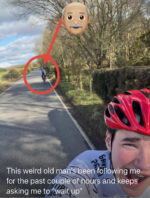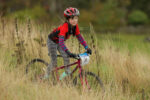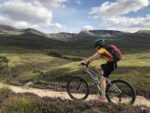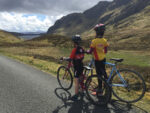The future of cycling is in the balance

 A fine art of balancing
A fine art of balancing
As a cycle coach, one of the most common questions I get asked by parents of young children is, “What is the quickest way to get my child to learn to ride a bike?” My immediate and unwavering response is to get them a balance bike. Both of my children learnt on them as young as two, and by the time they were three they were pedalling without ever having used stabilisers and were joining us on cycling trips into the Cairngorms.
The concept of the balance bike has been around for centuries and the design dates back to the early velocipede created by the German, Karl Drais. This was called a Laufmaschine, and the rider sat on the saddle and propelled the bike by walking his feet along the ground. Looking at drawings of Drais’s machine, it is difficult to see much difference in design to modern balance bikes, but why change something that clearly works?
The fine art of balancing is the fundamental key for anyone who wants to pedal a two-wheeled bike. However, most training methods for young riders give them the experience of riding a bike, but take away any need to learn to balance, hence the inevitable difficulty when the training wheels are removed and the hard part of cycling has to be learnt from scratch. Balance bikes teach a child to propel themselves forward using their feet, meanwhile finding a comfortable position on the bike. As their confidence grows, they can lift their feet for as little or as long as they want and let the bike roll along. For the very young rider this can take longer, but the fun is in the learning. For parents it can be a liberating experience. When my wife and I went for dog walks in the woods we normally wouldn’t have been able to go far pushing buggies, but with my daughter at four pedalling like she’d ridden for decades and my boy, just turned two, scooting along on his balance bike, we were able to walk for a couple of hours without a grumble of discontent from our two young wheelers who happily rode through puddles and up and over bumpy ground.
Even in a world of TV and computerised games, the sheer joy for a child when they learn to ride a bike leads to a path of discovery and adventure before them. This journey starts with a balance bike, but it is when a child has mastered the act of balance that the fun begins. On many occasions I’ve seen children that have learnt to balance put down their balance bike and pick up a pedal bike and go straight away; it was that easy. For my own two, it took a few minutes, five at the most to get to grips with the pedals, but it still wasn’t long before they were hurtling down the dirt track beside our house, whooping with delight.
For many of you reading this, however, you may have already gone to the expense of buying a bike with pedals and you don’t want to spend more money on buying a balance bike; the simple answer is take the pedals off and voila, you have a balance bike.
More manufacturers are adding balance bikes into their children’s range and the choice available is ever widening. For me, the key factor is to keep it simple on the bike, if a child is distracted by other bits and pieces on the bike they will take longer to learn to balance.
Whichever bike you choose, it is a good idea, where possible, to try out the bike first, but in general balance bikes are so basic that you can’t really go wrong as long as you have the right size.
Some features to look out for:
Minimum inside leg measurement – this will dictate the child’s ability to sit on the saddle and touch the ground with their feet, also known as step-over height. The lower the measurement, the more suitable the bike is for younger children, or those with shorter legs. Most of the bikes have adjustable seat heights that allow the saddle to be raised as your child grows.
Rear brake – some balance bikes don’t have a brake which means the rider has less to think about as they learn. However, as they grow in confidence and speed, a brake is recommended. Some balance bikes that don’t come fitted with a brake have an option to buy the brake as required. My two children learnt without a brake until they got a pedal bike. I feel it helped with perception and control of speed, but their mother wasn’t convinced when the soles of their shoes wore out.
Weight – the heavier a bike is, the more difficult it will be to ride and is likely to discourage smaller children.
Steering limiter – most of the balance bikes come with a steering limiter that prevents the handlebars turning 360 degrees. These can limit the full steering motion and avoid the handlebars being turned at an acute angle and causing a fall.
Tyres – pneumatic tyres take more maintenance and upkeep, but are easy to replace and repair as required. Puncture proof tyres are more durable and may be a selling point for parents with no mechanical expertise.
Some balance bikes to consider
(Prices, sizes and details correct at time of writing)
 The Isla Bike Rothan Balance Bike – £129
The Isla Bike Rothan Balance Bike – £129
Colours – chilli red / hot pink
Minimum inside leg measurement –
30 cm (11.8”)
Rear brake – yes
Size – 12″ wheels, 4″ frame
Weight – 3.5 kgs (7 lbs 15 oz)
Frame – 7005 T6 heat treated aluminium
Fork – hi ten steel
Headset – 1″ ahead with steering limiter
Spokes – steel, black
Tyres – pneumatic with presta valve inner tube
Isla Rowntree is passionate about making kids bikes and the Rothan is an ideal starter balance bike with a sturdy, but light frame. Original Rothans were built without brakes, but the current design has one back brake that is easy to reach and pull with small fingers. The tyres are pneumatic with presta valve inner tubes that allow for a higher pressure. They require maintenance in the form of regular pumping, but this is something kids enjoy joining in with. They are not puncture proof, but tough wearing all the same. The popularity and quality of Isla Bikes is evident from the number of children that use them across the UK at youth and junior cycling events. At the mid price range they are a good mix of quality build and components without excess, and Isla Bikes even offer a buy back, part exchange scheme when buying a bigger bike from their range, dependant on the original bike’s condition – http://www.islabikes.co.uk/
The Strider PreBike ST3 – £84.99
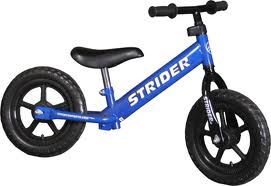
Colours – orange, red, pink, yellow, blue and green
Minimum inside leg measurement –
28 cm (11”)
Back brake – no but optional friction brake available
Wheels – 11”
Weight – 3.1 kg (6 lbs 9 oz) without optional brake
Frame – custom welded, thin gauge steel alloy
Fork – welded steel
Headset – no steering limiter
Spokes – plastic, black
Tyres – moulded foam
The Strider offers a light frame without a back brake which means the rider has to control their speed using their feet. This gives them one thing fewer to think about when they are learning. On the downside, however, as they gain confidence and speed this can wear shoes out quickly. The manufacturers offer an optional friction plate brake that is operated by using the foot to press the plate against the rear tyre. My reservation about this system is that the child is learning a braking system that will differ from the handlebar mounted brakes on their next bike. The Strider also has footplates on the rear stays that allow the rider to stand up as they roll. The moulded foam tyres are virtually maintenance free and are puncture proof. Lastly there is no steering limiter. The manufacturers claims that this allows a child to learn about setting their own steering limits through rider input.
http://www.stridersports.co.uk/
The Like a Bike Mini Forest – £169
Colours – natural beech wood with red, black or blue trim
Minimum inside leg measurement – 27 cm (10.5”)
Back brake – no
Weight – 3.5 kg (7.7 lbs)
Frame / fork – beech marine plywood
Headset – steering limiter
Spokes – steel, black
Tyres – pneumatic with Schrader valve inner tubes
Made in Germany by Kokua, the original Like a Bike was designed by Rolf Mertens in 1997 who is credited with being the originator of the new-wave of balance bikes now on the market. Very similar to the hobby horse of years gone by, the Like a Bike is made of wood. It’s a beautiful object to look at and of all the bikes reviewed here, it has the lowest stand over height, meaning that this should fit even the smallest of riders. Saddle adjustment is limited to four set heights, although a height extension post is available to accommodate a further 3 cm of stand over height. Interestingly, unlike the Strider, the Like a Bike has a steering limiter that Kokua claims avoids potential jack-knife crashes.
The full range of Like a Bike wooden bikes offers a multitude of choices including spoked and disc wheeled bikes, The Racer, which has skinnier wheels, and the Wing, which has integrated footrests. The Like a Bike is at the top end of the balance bike price range but, for those who like something to look a bit different, the design of this bike certainly makes it stand out.
http://www.likeabike.co.uk/
 Kokua Jumper – £155
Kokua Jumper – £155
Colours – Kawasaki green, bright red,
metallic purple, metallic red, juicy orange, metallic blue, royal blue, pearl white
Minimum inside leg measurement –
35 cm (10.5”)
Back brake – no but option for front brake to be fitted
Wheels – 12”
Weight – 3.4 kg (7.5 lbs)
Frame / fork – 7005 aluminium
Headset – steering limiter
Spokes – steel, silver
Tyres – pneumatic with Schrader valve inner tubes
The Jumper comes from the same stable as the wooden Like a Bike but, with a higher step-over height, it is suitable for older riders. The design, with the exception of the wooden framed Forest, is similar to many other balance bikes here, with one big exception – the Jumper has rear suspension. Whether you feel that a balance bike has the need for suspension or not, it is certainly a selling point that might attract both parents and children alike. My own opinion is that a rider who has progressed to the point of skill where they require suspension is generally ready to move up to a pedal bike. The Jumper has the highest step-over height of all the bikes here, so it certainly targets an older rider. Built for Kokua by folding bike specialists Dahon, the Jumper is certainly of a high quality build and looks great and has built in footrests.
http://www.likeabike.co.uk/
 Ridgeback Scoot – £99.99
Ridgeback Scoot – £99.99
Colours – lime, tangerine, silver,
matte grey, blue, purple, pink
Minimum inside leg measurement –
32 cm (12.6”)
Back brake – yes
Wheels – 12”
Weight – 3.4 kg (7.5 lbs)
Frame – 6061 heat treated aluminium
Fork – high ten steel
Headset – steering limiter
Spokes – steel, silver
Tyres – pneumatic with Schrader valve inner tubes
The Scoot is another great looking bike with a wide range of colours to suit the tastes of even the most choosy child. One feature on this bike that doesn’t appear on any other bike looked at here is the carry-grip on the saddle, which is ideal for parents who have to carry the bike when their child doesn’t want to ride it.
http://www.ridgeback.co.uk/bike/scoot-matte-grey

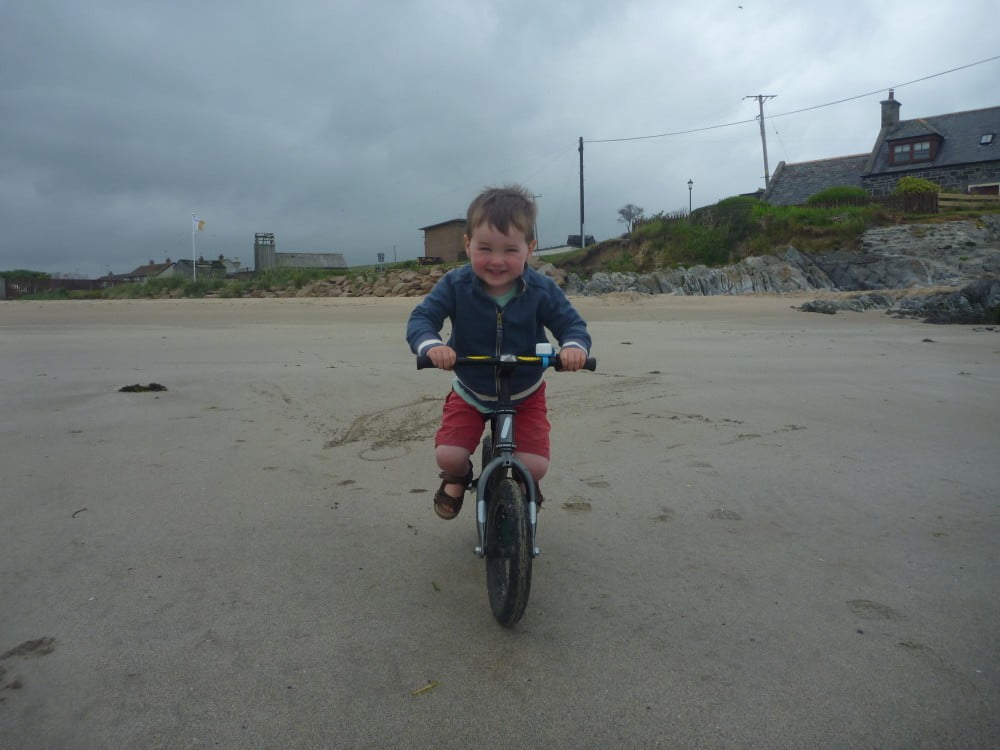
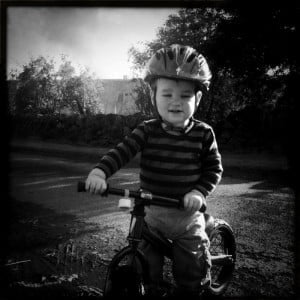
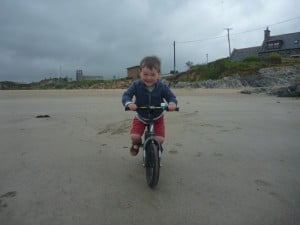 A fine art of balancing
A fine art of balancing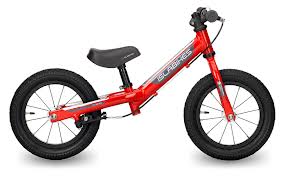 The Isla Bike Rothan Balance Bike – £129
The Isla Bike Rothan Balance Bike – £129 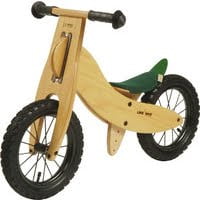
 Kokua Jumper – £155
Kokua Jumper – £155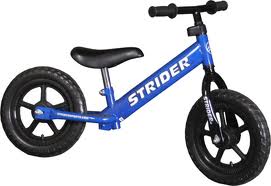 Ridgeback Scoot – £99.99
Ridgeback Scoot – £99.99